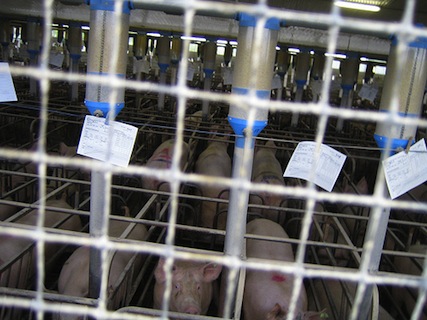
<a href="http://www.shutterstock.com/pic-140890144/stock-photo-little-piglets-suckling-their-mother-at-the-pig-factory.html?src=n2v1M8MUv0LZ0GdbkCc_FA-1-0" target="_blank">rtem</a>/Shutterstock
In November, the animal-welfare group Mercy for Animals released a video, captured by an undercover investigator, documenting alarming conditions on a hog farm contracted to meat giant Tyson Foods. Some of the actions caught on tape were truly awful: men kicking sows and pounding them with sheets of wood. But it was just as devastating to watch how those pregnant sows lived day to day: crammed individually into spaces so tight, they can’t turn around.
On Thursday, Tyson announced it had begun “urging” its hog contractors to “improve housing for pregnant sows…urging all future sow barn construction or remodeling to allow for pregnant sows of all sizes to stand, lie down, stretch their legs and turn around.” Granted, it’s a statement without teeth: It requests, not requires, action, and gives no timeline. But even Mercy for Animals acknowledged in an emailed statement that it “signals an important new era and direction for the company,” which had before resisted considerable pressure to take a stand on the practice.
Gestation crates really, really need to be phased out. As Ted Genoways showed so forcefully in his 2013 Mother Jones feature “Gagged by Big Ag,” the technique not only essentially tortures the sows, but it also puts the workers who handle them in danger—and leads them in turn to heap yet more abuse on the sows. Get this, from Genoways’ account of an interview with a Hormel worker who had been caught on tape in the act:
As we sat recently in the tiny, tumbledown house he grew up in and now shares with his wife and two kids, Lyons acknowledged—as he did to the sheriff’s deputy back then—that he had prodded sows with clothespins, hit them with broad, wooden herding boards, and pulled them by their ears, but only in an effort, he said, to get pregnant sows that had spent the last 114 days immobilized in gestation crates up and moving to the farrowing crates where they would give birth. Lyons said he never intended to hurt the hogs, that he was just “scared to death” of the angry sows “who had spent their lives in a little pen”—and this was how he had been trained to deal with them. Lyons had watery blue eyes that seemed always on the verge of tears and spoke in a skittish mutter that would sometimes disappear all the way into silence as he rubbed his thin beard. “You do feel sorry for them, because they don’t have much room to move around,” he said, but if they get spooked coming out of their crates, “you’re in for a fight.”
Did the revelations in the latest video inspire Tyson’s baby steps toward change? In its statement, Tyson attributed the announcement to its “ongoing animal well-being program,” “input we’ve received from our Animal Well-Being Advisory Panel, customers, farmers and industry experts,” and “our continuing efforts to balance the expectations of consumers with the realities of today’s hog farming business.”
But it’s becoming clear that videos like the Mercy for Animals one are increasingly shaping those consumer expectations. Tyson’s rival Smithfield found religion on hog crates after being burned by a particularly grotesque video in 2011. Unlike Tyson, which buys the great bulk of the pigs it slaughters from contract farmers, Smithfield is a massive hog producer in its own right, raising about 60 percent of its own sows. In 2010, it vowed to phase out the gestation crates in its company hog-production facilities by 2017. And just this week, Smithfield announced it would pressure its contract farmers, suppliers of the other 40 percent, to phase out crates by 2022.
The lesson from this trend is clear: When people see what goes on in factory farms, they don’t like it, and they force change (granted, at a slow and halting pace). And that is why, as Genoways’ Mother Jones piece demonstrates, the meat industry is fighting so hard to criminalize the act of secretly documenting conditions within these massive facilities.












